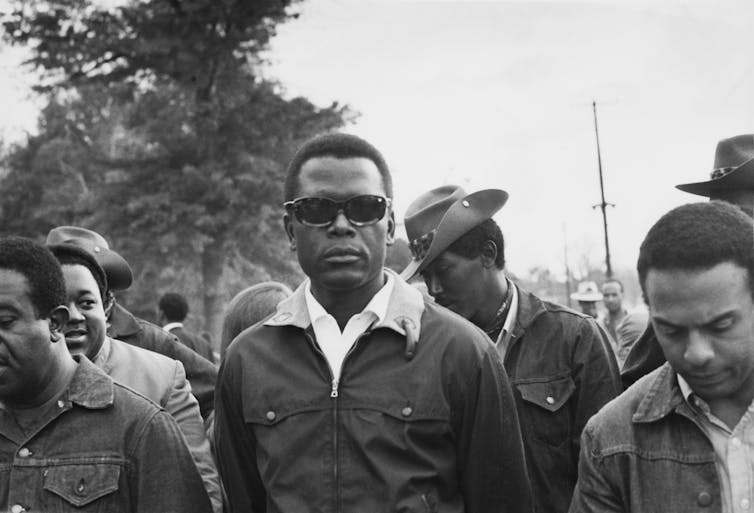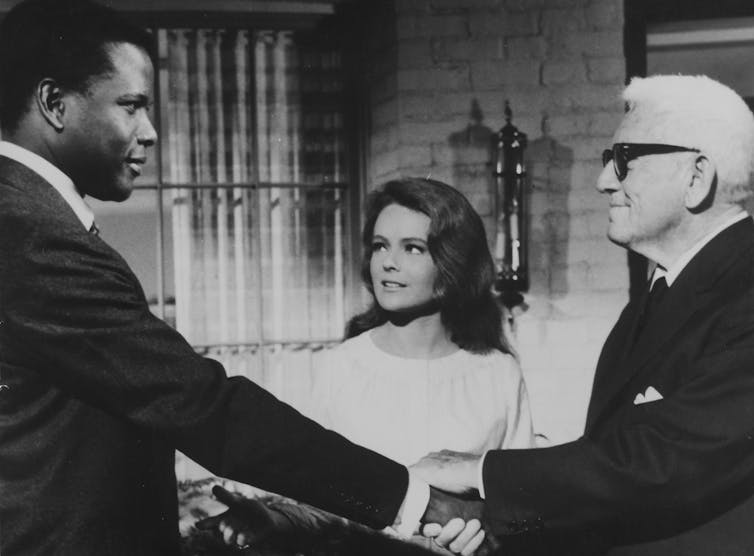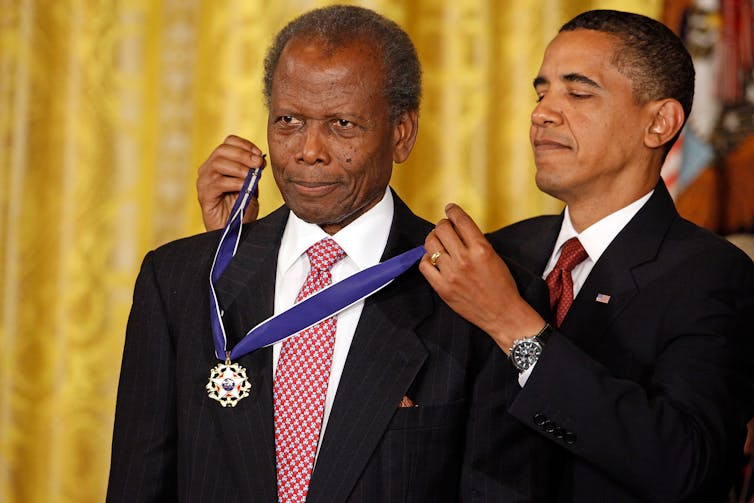Christian Elliott
National Geographic
JAN. 11,2022
When Crown Prince Akihito visited Chicago on October 3, 1960, his sole request was to visit Shedd Aquarium. Then Mayor Richard J. Daley, an avid angler, presented the prince with a gift that he scooped with a net from one of the tanks himself: 18 bluegills, the official Illinois state fish.

© Photograph by Associated Press Crown Prince Akihito of Japan looks at tropical fish at the Coney Island Aquarium in New York on Sept. 30, 1960. In the background is Dr Christopher Coates, director of the aquarium. Akihito is in New York as part of the Japanese royals state visit

© Photograph by Joel Sartore, National Geographic Photo Ark
A studio portrait of a bluegill, Lepomis macrochirus.
LONG READ
The 26-year-old future emperor was already a passionate ichthyologist, and he planned to stock the exotic fish in the moat surrounding his palace, according to accounts in the Chicago Tribune at the time.
At windy Chicago O’Hare International Airport the next day with Princess Michiko, Akihito bid the city farewell, carrying a gift that he couldn’t have imagined would cause a decades-long ecological crisis in his homeland.
In the intervening six decades, the bluegills became an invasive, species-destroying nightmare, crowding Japanese freshwater lakes and rivers and destroying native fish biodiversity, says Kenji Saitoh, a researcher at the country’s Fisheries Resources and Education Agency.
The 26-year-old future emperor was already a passionate ichthyologist, and he planned to stock the exotic fish in the moat surrounding his palace, according to accounts in the Chicago Tribune at the time.
At windy Chicago O’Hare International Airport the next day with Princess Michiko, Akihito bid the city farewell, carrying a gift that he couldn’t have imagined would cause a decades-long ecological crisis in his homeland.
In the intervening six decades, the bluegills became an invasive, species-destroying nightmare, crowding Japanese freshwater lakes and rivers and destroying native fish biodiversity, says Kenji Saitoh, a researcher at the country’s Fisheries Resources and Education Agency.

Photograph by Trevor Mogg, Alamy Stock Photo People fishing in Lake Biwa (Biwako), Shiga Prefecture, Japan.
Fortunately, science has marched on in 60 years. Now, Japanese geneticists are experimenting with the gene editing wizardry of CRISPR to sterilize the invasive bluegills. If the initiative succeeds, wildlife managers could use the same technique to rid the U.S. of damaging aquatic invasives such as the Asian carp.
In Japan, the public is ambivalent about the bluegills and wary of genetic efforts to curtail them, and it’s easy to see why. The 60-year history of bluegill in Japan is a cautionary tale about human intervention on all sides.
The invasion begins
When he arrived home after his 1960 U.S. tour, Akihito asked Japan’s national Agency of Fisheries to breed the 15 captive bluegills that survived the trans-Pacific journey, in hopes of releasing them into the wild as a new game fish, nicknamed the “prince fish” in his honor. In 1966, the bluegills’ offspring were deposited into Lake Ippeki-ko outside Ito City in Japan’s Shizuoka Prefecture. Three years later, a stone monument was placed on the shore to celebrate the prince fish’s successful introduction. More bluegills were released into freshwater ecosystems across Japan.
“At that time, we had not experienced any serious invasive species problems and bluegill did not look dangerous according to its feeding habits, not being a fierce piscivore,” says Nakai Katsuki, a Japanese research scientist at the Lake Biwa Museum who has studied invasive North American fish species in Japan’s Shiga Prefecture since 1989.
The Japanese government soon stopped breeding bluegill because the fish grew slowly in captivity. For a while, the bluegill was largely forgotten, says Katsuki.
But in the meantime, the fish thrived unnoticed in the wild, multiplying in Japan’s rivers, lakes, and streams, expanding its diet beyond insects, plankton, and aquatic plants to shrimp and native fish eggs. In their North American habitats, bluegills reproduce quickly and live for a long time, whereas in Japan, native shoreline fish had temporarily kept the bluegill population under control by eating their eggs and juveniles.
By 1999, the bluegill had colonized all freshwater ecosystems in the country, spurring government-supported research into bluegill dispersal. But by then, it was way too late.
Ineffectual resistance
In 2000, Saitoh, who specializes in fish genetics and evolution, went to the U.S. to track the origins of Japan’s bluegill. At the time, Japanese scientists fiercely debated whether the ubiquitous fish really originated from one source.
The research team, led by biologist Kouichi Kawamura at Mie University, southwest of Tokyo, compared mitochondrial DNA from 13 different populations of U.S. bluegill to 56 populations in Japan. In a pool of the Mississippi River near Guttenberg, Iowa, a small town nestled against limestone bluffs, the team found a perfect match: All of the prince fish originated from the 15 bluegills gifted to Akihito by Daley decades earlier. Limited genetic diversity from inbreeding didn’t seem to hinder the bluegills in Japan at all.
By now, the bluegills posed a serious threat to important native species across the country. In Lake Biwa, Japan’s largest and oldest freshwater body, bluegills decimated the Crucian carp population, a fish unique to the lake and beloved as a fermented delicacy called funazushi. So the Shiga Prefectural Government placed a $3 per kilogram bounty on bluegill to encourage commercial fishermen to target them, and enacted a $1,000 fine for restocking bluegill and bass for lure fishing. Several research teams designed new types of traps to capture bluegill and their eggs. In 2002, the Japanese Ministry of the Environment formally identified bluegill as an invasive threat.
The Prefectural Government created a website promoting recipes for bluegill, hoping to encourage people to eat the fish. A local seafood processing firm sold bluegill sushi and funazushi bluegill. Nearby Fukui University tried selling a bluegill “eco-burger.” None caught on, according to Katsuki.
“Originally accepted and celebrated as a tasty fish,” Katsuki said, by 2002 bluegill had become “an infamous fish because of its invasiveness. In this process, the good taste of bluegill has been almost forgotten in Japan.”
In June 2005, Japan’s national Invasive Alien Species Act outlawed importing, possessing, and transporting 97 species, including bluegill. Two years later, Emperor Akihito issued a formal apology for having introduced the fish to the country in what the Japan Times called “a rare expression of contrition.” “My heart aches to see it has turned out like this,” Akihito said.
By 2007, the prince fish population reached an estimated 25 million. Along with bass, introduced from the U.S. for sport fishing in the 1970s, the invader accounted for 90 percent of all fauna in Lake Biwa, once home to 30 native fish species. In 2005, the Shiga Prefectural Government spent $1.2 million to remove 420 tons of invasive fish from the lake. Thanks to continual government-sponsored commercial fishing the population has halved since then, but bluegill and bass remain in the lake, as traditional gill nets can’t capture small juvenile fish. Over the past three years, eradication efforts cost the prefectural government $270,000 annually. If fishing ceased, the bluegill population would rise again.
“The number of habitats seems to have a little decreased, and the population size in large waters like Lake Biwa has declined since 2005, but the distribution does not seem to have decreased,” says Kawamura. “I am not hopeful for the future.”
A solution that may not happen
At long last, technology could provide an answer. Ongoing research led by fish geneticist Hiroyuki Okamoto focuses on “gene-induced suppression for alien populations” using the gene editing tool CRISPR-Cas9. Okamoto’s team sequenced the bluegill genome and recently produced first-generation male fish that could carry a female-specific sterile gene into the wild bluegill population, eliminating their ability to produce eggs. The program is in its sixth year in the lab.
While genetic sterilization seems to work, Okamoto estimates he would need to release a number of altered fish equivalent to 7 percent of the invasive population to completely eradicate bluegill in Japan’s waterways. Still, he thinks gene suppression could succeed.
The task may seem arduous, but “there is no more efficient way to eliminate the invasive species,” Okamoto says. “Contract commercial fishing takes time, it needs a budget, and in Japan that budget is very small and getting smaller, because we have been doing it already for 20 years. Now that we have CRISPR technology, maybe there’s a possibility to solve this problem.”
Still, he’s not sure officials will approve releasing his sterile gene-carrying bluegill into natural ecosystems. Okamoto said he faces online criticism and threats for his work from people who say organisms altered with CRISPR don’t belong in the wild.
“While we are aware of the genetic methods designed to disrupt the reproduction of bluegill, we remain cautious of the potential impacts on native ecosystems and their relations in law and regulations,” Masaki Ohara, section chief of the International Strategy Division of the Japanese Ministry of the Environment said in an email.
There’s another major obstacle: limited public support in Japan for bluegill management in general.
Okamoto compared the U.S. Invasive Carp Regional Coordinating Committee’s 2021 $45 million budget to the $16 million Japanese budget for all inland fishery issues. “Seeing this,” he says, “I think U.S. people have much more concern about invasive fish issues.”
Saitoh agrees. “Ordinary people do not pay much attention to what’s happening in the water because it is invisible to them.”
No 'silver bullet'
Across the globe in Illinois, where Japan’s bluegills originated, Kevin Irons is dealing with an invasive species of his own: Asian carp. As aquatic nuisance species program manager at the Illinois Department of Natural Resources, he oversees mass capture efforts to remove 750 tons of carp along the 330-mile length of the Illinois River Basin each year.
Over the past decade, Japanese and U.S. scientists have occasionally swapped advice and methods for controlling their respective invasives. Irons’ teams collect water samples to test for DNA from sloughed-off carp cells, a technique pioneered by Japanese geneticists to track bluegill. In 2012, Nakai Katsuki, the Lake Biwa Museum fish researcher, flew to St. Paul, Minnesota to present advances in electrofishing and artificial nests design to a conference of carp managers. He remembers eating fried silver carp, rebranded “silverfin.”
Despite his best efforts, there doesn’t seem to be “a silver bullet out there right now to eradicate carp,” Irons says.
But the technique Okamoto’s team is developing in Japan—genetic biocontrol, or “gene drive”—has been called just that by some U.S. National Academy of Sciences researchers.
“The implications are potentially remarkable: For the first time we may genuinely have a tool with the power to permanently eliminate a target species from the planet,” three scientists wrote in the Proceedings of the National Academy of Sciences in 2015, just before Okamoto’s work started in earnest.
“The question is no longer whether we can control invasive species using gene drive,” they wrote, “but whether we should.”
But there are tradeoffs and risks with the technique, researchers say, such as unintended off-target mutations that spread through the population for generations, or the global loss of a species if modified individuals somehow escaped and returned to their native habitat. It’s also possible that another invasive would quickly fill the vacant niche.
As the decades have demonstrated, whether a Japanese prince takes a souvenir tank of bluegills home or a U.S. farmer imports silver carp from eastern China, as with any human environmental intervention, good intentions aren’t always good enough.
Fortunately, science has marched on in 60 years. Now, Japanese geneticists are experimenting with the gene editing wizardry of CRISPR to sterilize the invasive bluegills. If the initiative succeeds, wildlife managers could use the same technique to rid the U.S. of damaging aquatic invasives such as the Asian carp.
In Japan, the public is ambivalent about the bluegills and wary of genetic efforts to curtail them, and it’s easy to see why. The 60-year history of bluegill in Japan is a cautionary tale about human intervention on all sides.
The invasion begins
When he arrived home after his 1960 U.S. tour, Akihito asked Japan’s national Agency of Fisheries to breed the 15 captive bluegills that survived the trans-Pacific journey, in hopes of releasing them into the wild as a new game fish, nicknamed the “prince fish” in his honor. In 1966, the bluegills’ offspring were deposited into Lake Ippeki-ko outside Ito City in Japan’s Shizuoka Prefecture. Three years later, a stone monument was placed on the shore to celebrate the prince fish’s successful introduction. More bluegills were released into freshwater ecosystems across Japan.
“At that time, we had not experienced any serious invasive species problems and bluegill did not look dangerous according to its feeding habits, not being a fierce piscivore,” says Nakai Katsuki, a Japanese research scientist at the Lake Biwa Museum who has studied invasive North American fish species in Japan’s Shiga Prefecture since 1989.
The Japanese government soon stopped breeding bluegill because the fish grew slowly in captivity. For a while, the bluegill was largely forgotten, says Katsuki.
But in the meantime, the fish thrived unnoticed in the wild, multiplying in Japan’s rivers, lakes, and streams, expanding its diet beyond insects, plankton, and aquatic plants to shrimp and native fish eggs. In their North American habitats, bluegills reproduce quickly and live for a long time, whereas in Japan, native shoreline fish had temporarily kept the bluegill population under control by eating their eggs and juveniles.
By 1999, the bluegill had colonized all freshwater ecosystems in the country, spurring government-supported research into bluegill dispersal. But by then, it was way too late.
Ineffectual resistance
In 2000, Saitoh, who specializes in fish genetics and evolution, went to the U.S. to track the origins of Japan’s bluegill. At the time, Japanese scientists fiercely debated whether the ubiquitous fish really originated from one source.
The research team, led by biologist Kouichi Kawamura at Mie University, southwest of Tokyo, compared mitochondrial DNA from 13 different populations of U.S. bluegill to 56 populations in Japan. In a pool of the Mississippi River near Guttenberg, Iowa, a small town nestled against limestone bluffs, the team found a perfect match: All of the prince fish originated from the 15 bluegills gifted to Akihito by Daley decades earlier. Limited genetic diversity from inbreeding didn’t seem to hinder the bluegills in Japan at all.
By now, the bluegills posed a serious threat to important native species across the country. In Lake Biwa, Japan’s largest and oldest freshwater body, bluegills decimated the Crucian carp population, a fish unique to the lake and beloved as a fermented delicacy called funazushi. So the Shiga Prefectural Government placed a $3 per kilogram bounty on bluegill to encourage commercial fishermen to target them, and enacted a $1,000 fine for restocking bluegill and bass for lure fishing. Several research teams designed new types of traps to capture bluegill and their eggs. In 2002, the Japanese Ministry of the Environment formally identified bluegill as an invasive threat.
The Prefectural Government created a website promoting recipes for bluegill, hoping to encourage people to eat the fish. A local seafood processing firm sold bluegill sushi and funazushi bluegill. Nearby Fukui University tried selling a bluegill “eco-burger.” None caught on, according to Katsuki.
“Originally accepted and celebrated as a tasty fish,” Katsuki said, by 2002 bluegill had become “an infamous fish because of its invasiveness. In this process, the good taste of bluegill has been almost forgotten in Japan.”
In June 2005, Japan’s national Invasive Alien Species Act outlawed importing, possessing, and transporting 97 species, including bluegill. Two years later, Emperor Akihito issued a formal apology for having introduced the fish to the country in what the Japan Times called “a rare expression of contrition.” “My heart aches to see it has turned out like this,” Akihito said.
By 2007, the prince fish population reached an estimated 25 million. Along with bass, introduced from the U.S. for sport fishing in the 1970s, the invader accounted for 90 percent of all fauna in Lake Biwa, once home to 30 native fish species. In 2005, the Shiga Prefectural Government spent $1.2 million to remove 420 tons of invasive fish from the lake. Thanks to continual government-sponsored commercial fishing the population has halved since then, but bluegill and bass remain in the lake, as traditional gill nets can’t capture small juvenile fish. Over the past three years, eradication efforts cost the prefectural government $270,000 annually. If fishing ceased, the bluegill population would rise again.
“The number of habitats seems to have a little decreased, and the population size in large waters like Lake Biwa has declined since 2005, but the distribution does not seem to have decreased,” says Kawamura. “I am not hopeful for the future.”
A solution that may not happen
At long last, technology could provide an answer. Ongoing research led by fish geneticist Hiroyuki Okamoto focuses on “gene-induced suppression for alien populations” using the gene editing tool CRISPR-Cas9. Okamoto’s team sequenced the bluegill genome and recently produced first-generation male fish that could carry a female-specific sterile gene into the wild bluegill population, eliminating their ability to produce eggs. The program is in its sixth year in the lab.
While genetic sterilization seems to work, Okamoto estimates he would need to release a number of altered fish equivalent to 7 percent of the invasive population to completely eradicate bluegill in Japan’s waterways. Still, he thinks gene suppression could succeed.
The task may seem arduous, but “there is no more efficient way to eliminate the invasive species,” Okamoto says. “Contract commercial fishing takes time, it needs a budget, and in Japan that budget is very small and getting smaller, because we have been doing it already for 20 years. Now that we have CRISPR technology, maybe there’s a possibility to solve this problem.”
Still, he’s not sure officials will approve releasing his sterile gene-carrying bluegill into natural ecosystems. Okamoto said he faces online criticism and threats for his work from people who say organisms altered with CRISPR don’t belong in the wild.
“While we are aware of the genetic methods designed to disrupt the reproduction of bluegill, we remain cautious of the potential impacts on native ecosystems and their relations in law and regulations,” Masaki Ohara, section chief of the International Strategy Division of the Japanese Ministry of the Environment said in an email.
There’s another major obstacle: limited public support in Japan for bluegill management in general.
Okamoto compared the U.S. Invasive Carp Regional Coordinating Committee’s 2021 $45 million budget to the $16 million Japanese budget for all inland fishery issues. “Seeing this,” he says, “I think U.S. people have much more concern about invasive fish issues.”
Saitoh agrees. “Ordinary people do not pay much attention to what’s happening in the water because it is invisible to them.”
No 'silver bullet'
Across the globe in Illinois, where Japan’s bluegills originated, Kevin Irons is dealing with an invasive species of his own: Asian carp. As aquatic nuisance species program manager at the Illinois Department of Natural Resources, he oversees mass capture efforts to remove 750 tons of carp along the 330-mile length of the Illinois River Basin each year.
Over the past decade, Japanese and U.S. scientists have occasionally swapped advice and methods for controlling their respective invasives. Irons’ teams collect water samples to test for DNA from sloughed-off carp cells, a technique pioneered by Japanese geneticists to track bluegill. In 2012, Nakai Katsuki, the Lake Biwa Museum fish researcher, flew to St. Paul, Minnesota to present advances in electrofishing and artificial nests design to a conference of carp managers. He remembers eating fried silver carp, rebranded “silverfin.”
Despite his best efforts, there doesn’t seem to be “a silver bullet out there right now to eradicate carp,” Irons says.
But the technique Okamoto’s team is developing in Japan—genetic biocontrol, or “gene drive”—has been called just that by some U.S. National Academy of Sciences researchers.
“The implications are potentially remarkable: For the first time we may genuinely have a tool with the power to permanently eliminate a target species from the planet,” three scientists wrote in the Proceedings of the National Academy of Sciences in 2015, just before Okamoto’s work started in earnest.
“The question is no longer whether we can control invasive species using gene drive,” they wrote, “but whether we should.”
But there are tradeoffs and risks with the technique, researchers say, such as unintended off-target mutations that spread through the population for generations, or the global loss of a species if modified individuals somehow escaped and returned to their native habitat. It’s also possible that another invasive would quickly fill the vacant niche.
As the decades have demonstrated, whether a Japanese prince takes a souvenir tank of bluegills home or a U.S. farmer imports silver carp from eastern China, as with any human environmental intervention, good intentions aren’t always good enough.













